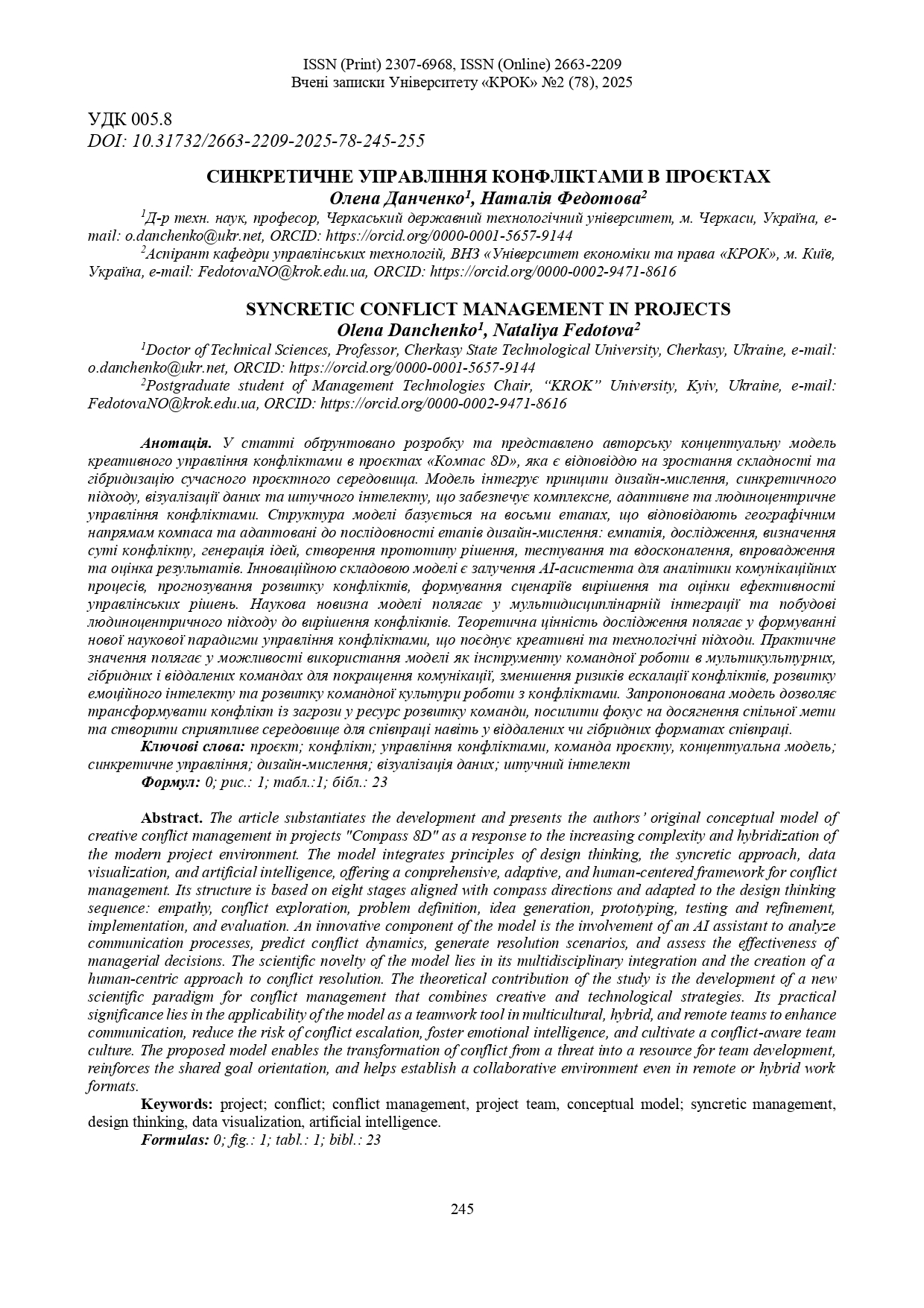СИНКРЕТИЧНЕ УПРАВЛІННЯ КОНФЛІКТАМИ В ПРОЄКТАХ
DOI:
https://doi.org/10.31732/2663-2209-2025-78-245-255Ключові слова:
проєкт, управління конфліктами, команда проєкту, концептуальна модель, синкретичне управління, дизайн-мислення, штучний інтелектАнотація
У статті обґрунтовано розробку та представлено авторську концептуальну модель креативного управління конфліктами в проєктах «Компас 8D», яка є відповіддю на зростання складності та гібридизацію сучасного проєктного середовища. Модель інтегрує принципи дизайн-мислення, синкретичного підходу, візуалізації даних та штучного інтелекту, що забезпечує комплексне, адаптивне та людиноцентричне управління конфліктами. Структура моделі базується на восьми етапах, що відповідають географічним напрямам компаса та адаптовані до послідовності етапів дизайн-мислення: емпатія, дослідження, визначення суті конфлікту, генерація ідей, створення прототипу рішення, тестування та вдосконалення, впровадження та оцінка результатів. Інноваційною складовою моделі є залучення AI-асистента для аналітики комунікаційних процесів, прогнозування розвитку конфліктів, формування сценаріїв вирішення та оцінки ефективності управлінських рішень. Наукова новизна моделі полягає у мультидисциплінарній інтеграції та побудові людиноцентричного підходу до вирішення конфліктів. Теоретична цінність дослідження полягає у формуванні нової наукової парадигми управління конфліктами, що поєднує креативні та технологічні підходи. Практичне значення полягає у можливості використання моделі як інструменту командної роботи в мультикультурних, гібридних і віддалених командах для покращення комунікації, зменшення ризиків ескалації конфліктів, розвитку емоційного інтелекту та розвитку командної культури роботи з конфліктами. Запропонована модель дозволяє трансформувати конфлікт із загрози у ресурс розвитку команди, посилити фокус на досягнення спільної мети та створити сприятливе середовище для співпраці навіть у віддалених чи гібридних форматах співпраці
Завантаження
Посилання
Bedrii, Dmytro. (2020). Development of a model of integrated risk and conflict management of scientific project stakeholders under conditions of behavioral economy. Technology audit and production reserves. 3. 9-14. 10.15587/2706-5448.2020.207086.
El Khatib, Mounir & Alawadhi, Hamad. (2024). How Design Thinking Can Add Value to Project Management. International Journal of Business Analytics and Security (IJBAS). 4. 39-54. 10.54489/ijbas.v4i2.351
Lokhande, A. (2022). Use of Artificial Intelligence Smart Tools in Projects. 2022 8th International Conference on Smart Structures and Systems (ICSSS), 1-6. https://doi.org/10.1109/ICSSS54381.2022.9782273.
Munkvold, R., Kolås, L., & Palmquist, A. (2023). A Conflict Management Game in Project-based Learning. https://doi.org/10.34190/ecgbl.17.1.1375
Oksamutna, L. P. & Torba, T. V., (2024). Overview of modern approaches to conflict management in distributed IT-projects. Management of Development of Complex Systems, 59, 73–80, dx.doi.org10.32347/2412-9933.2024.59.73-80
Project Management Institute. (2021). A guide to the project management body of knowledge (PMBOK® Guide) (7th ed.). Project Management Institute.
Rösch, N., Tiberius, V. and Kraus, S. (2023), "Design thinking for innovation: context factors, process, and outcomes", European Journal of Innovation Management, Vol. 26 No. 7, pp. 160-176. https://doi.org/10.1108/EJIM-03-2022-0164
Scarlat, C., & Bărar, D.-A. S. (2024). Towards a Transcultural Approach for Inter-Professional Communication in Complex IT Project Teams—Aiming to Avoid Cross-Functional and Cross-Hierarchical Conflicts. Systems, 12(1), 10. https://doi.org/10.3390/systems12010010
Schwarz, Jan Oliver & Wach, Bernhard & Rohrbeck, René. (2023). How to Anchor Design Thinking in the Future: Empirical Evidence on the Usage of Strategic Foresight in Design Thinking Projects. Futures. 149. 103137. 10.1016/j.futures.2023.103137.
Бачинський, О. (2024). ВИКОРИСТАННЯ ШТУЧНОГО ІНТЕЛЕКТУ ЯК ІНСТРУМЕНТУ УПРАВЛІННЯ ПРОЄКТАМИ. Економіка та суспільство, (61). https://doi.org/10.32782/2524-0072/2024-61-18
Бушуєв, С. Д., Івко, А. В., Лященко, Т. О., & Тихонова, О. О. (2024). Синкретичне управління інноваційними проєктами. Управління розвитком складних систем, (57), 20–26. https://doi.org/10.32347/2412-9933.2024.57.20-26
Бушуєв, С., Івко, А., & Тихонович, Ю. (2024). Синкретичне управління проєктами в епоху вибуху штучного інтелекту. Екологічна безпека та природокористування, 49(1), 85–98. https://doi.org/10.32347/2411-4049.2024.1.85-98
Григорович, А.Г., & Григорович, Б.А. (2018). Технології візуалізації даних. Web of Scholar, 4(22)
Данченко , О. ., & Федотова , Н. . (2024). Огляд сучасних моделей і методів управління конфліктами у проєктах. Управління розвитком складних систем, (60), 44–55. https://doi.org/10.32347/2412-9933.2024.60.44-55
Данченко, О. Б., Бедрій, Д. І., & Семко, І. Б. (2018). Концептуальна модель формування високоефективної команди проекту. Вісник Національного технічного університету "ХПІ". Серія: Стратегічне управління, управління портфелями, програмами та проектами = Bulletin of the National Technical University "KhPI". Series: Strategic management, portfolio, program and project management : зб. наук. пр. – Харків : НТУ "ХПІ", 2018. – № 1 (1277). – С. 51-56
Лелюк, С., Алексєєнко, І., & Полтініна, О. (2021). ВІЗУАЛІЗАЦІЯ ДАНИХ В УПРАВЛІННІ ПРОЕКТАМИ ФІНАНСОВОЇ СФЕРИ. Економіка та суспільство, (26). https://doi.org/10.32782/2524-0072/2021-26-74
Мартиняк, І., & Бакушевич, І. (2024). ГІБРИДНІ МОДЕЛІ УПРАВЛІННЯ ПРОЄКТАМИ В УМОВАХ СТАЛОГО РОЗВИТКУ ТА ЦИФРОВОЇ ЕКОНОМІКИ. Сталий розвиток економіки, (3(50), 21-26. https://doi.org/10.32782/2308-1988/2024-50-4
МЕЛЬНИЧЕНКО, О., & МЕЛЬНИЧЕНКО, М. (2022). КОНФЛІКТИ В УПРАВЛІННІ ПРОЄКТАМИ ПІДПРИЄМНИЦЬКИХ СТРУКТУР. Herald of Khmelnytskyi National University. Economic Sciences, 308(4), 26-30. https://doi.org/10.31891/2307-5740-2022-308-4-4
Мушинський, О. (2024). ОСОБЛИВОСТІ УПРАВЛІННЯ ПРОЄКТНИМИ КОМАНДАМИ В ГІБРИДНОМУ СЕРЕДОВИЩІ. Економіка та суспільство, (60). https://doi.org/10.32782/2524-0072/2024-60-5
Огороднік, М. (2025). ГІБРИДНЕ УПРАВЛІННЯ КОМАНДАМИ В ПРОЄКТНОМУ МЕНЕДЖМЕНТІ: ВИКЛИКИ ТА ПІДХОДИ ДЛЯ ДОСЯГНЕННЯ РЕЗУЛЬТАТІВ. Економіка та суспільство, (72). https://doi.org/10.32782/2524-0072/2025-72-51
Ровенська, В., Смирнова, І., & Латишева, О. (2023). КОМУНІКАЦІЇ ТА УПРАВЛІННЯ КОНФЛІКТАМИ В ОПЕРАЦІЙНИХ ТА ІТ ПРОЄКТАХ. Вісник Приазовського Державного Технічного Університету. Серія: Економічні науки, (1(38), 12–20. https://doi.org/10.31498/2225-6725.1(38).2023.280727
Триус, Ю., Ткаченко, Є. (2024). Особливості управління командою ІТ-проєкту в умовах віддаленої роботи. Управління розвитком складних систем, (60), 105–112. https://doi.org/10.32347/2412-9933.2024.60.105-112
ШАРОВ, В. (2024). ДИЗАЙН-МИСЛЕННЯ: КОНЦЕПЦІЯ ТА КЛЮЧОВІ ЕТАПИ. Development Service Industry Management, (2), 259–264. https://doi.org/10.31891/dsim-2024-6(41)

Downloads
Опубліковано
Як цитувати
Номер
Розділ
Ліцензія

Ця робота ліцензується відповідно до Creative Commons Attribution-NonCommercial 4.0 International License.

